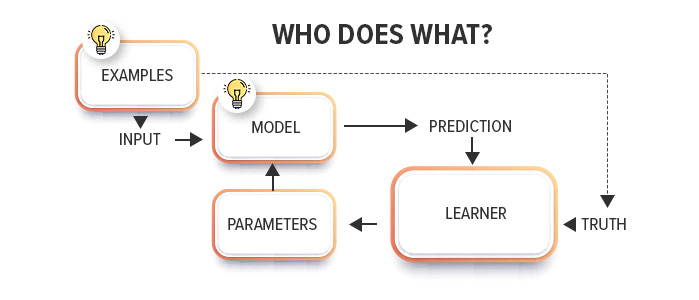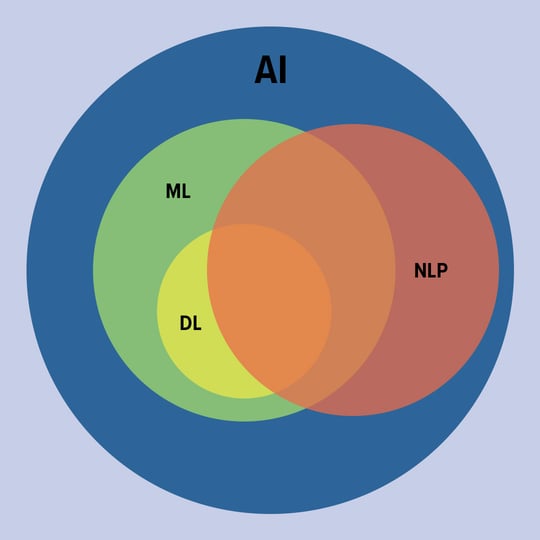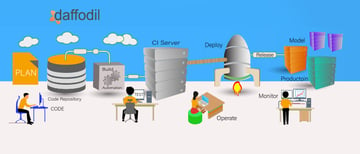.jpg?width=700&name=blog%20banner%20(5).jpg)
In today's advanced competitive world, the most valuable commodity is data. Data has many forms, from pictures of people and places to patient records and banking transactions. Machine Learning is a branch of Artificial Intelligence that can fully leverage this data to learn from it and enhance a business' bottom line.
Machine learning models can program and train themselves by repetitively processing a business' data. Eventually, after several iterations, the computing model identifies patterns in the data so that previous inefficiencies are eliminated and accurate predictions can be made.
We will first try to demystify what machine learning is all about in this article. We will go on to talk about how it works, its types, real-life use cases, and more.
|
Table Of Contents |
What Is Machine Learning?
Machine learning can be broadly defined as a subfield of artificial intelligence which involves computers mimicking human learning capabilities. While initially machine learning computing models are programmed to carry out data interpretation tasks, over time these models train themselves on the data and in a way, begin programming themselves.
Machine learning models begin working with a set of data presented to them by humans and over time decide on their own what actions to take.
A machine learning model or system functions in three ways based on how it interacts with data being fed to it:
- The descriptive analysis model looks into past data to outline, classify and draw out valuable information from it.
- The predictive analysis model examines past and current data to identify future probabilities.
- The prescriptive analysis model draws patterns from existing data to map out the best course of action going ahead in a workflow.
How Does Machine Learning Work?
Now that we have a basic outline of machine learning, we should go on to discuss how machine learning really works. There is an underlying process that defines how machine learning models identify patterns in data, images, and text in everyday business use cases.

A machine learning system can be divided into three parts:
- Model: The central entity that is responsible for identifying data elements and making predictions based on them.
- Parameters: The various incoming signals and factors from the data set that the model bases its decisions on.
- Learner: This subsystem of the machine learning system makes adjustments to the parameters and the model to increase the efficiency of the system.
How the machine learning model works can be demonstrated through the example of the dinosaur game that starts when your Google Chrome page times out. The game is supposedly designed to never end so you can never actually finish the game.
A human would figure out the game through trial and error, making the dinosaur jump every time it comes across a hurdle in the form of a pixelated cactus or bird. Similar to how a human would learn the game dynamic by playing it twice or thrice, a machine learning model programmed to identify the pixelated cactus would do so through a bunch of iterations of the game.
Another example of how a machine learning model works can be shown through the identification of a numbered series. Let's consider the following sequence of numbered pairs:
- 1-1
- 2-8
- 3-27
If you were told that the next pair in the series starts with a 4 on the left side, what would your guess for its pair be? As we can observe here, the second number is the cube of the left one. So the numbered pair would be 4-64.
A human being would observe the series of numbered pairs and predict the next pair in the sequence. A machine learning model also works out the next pair in a similar way. In a purely mathematical way, it observes the accumulated information in the sequence to predict the next pair. This is how a variety of business applications of AI are carried out in practice.
So, ultimately, the way machine learning works can be broken down into the following steps:
1)Decision process: Machine learning algorithms are primarily implemented for making predictions and classification tasks. Some labeled or unlabeled input data is provided to the algorithm, based on which the machine learning model will attempt to identify patterns in the data.
2)Identifying exceptions: Machine learning models can define exceptions or error functions to comprehensively assess their own predictive capabilities. Based on previously successful use cases, the error function can gauge the accuracy of the model by making comparisons to the original use cases.
3)Model optimization: The model then makes calibrations in its underlying algorithms so that the discrepancy between the successful use cases and the current estimates is reduced. This process of evaluation and optimization is repeated over several iterations, as the model learns to automatically keep improving its predictions and pattern recognition capabilities.

How To Build A Machine Learning Model
The creation of a machine learning model is done along the lines of the development of any product. It involves planning, research, resource allocation, and so on. The entire process is spread across the following few steps:
1)Accumulate Training Data
The foundation of an efficient machine learning model is quality training data. The training dataset consists of a collection of data points that point to the solution of the problem that the machine learning model is being employed. It is essentially a series of clues and real-world examples that help the machine learning model correlate the solution for the task at hand. There should be no duplicate values in the training dataset and can be fully or partially labeled.
2)Select The Right Algorithm
There are a range of algorithms to choose from, such as linear regression, logistic regression, k-nearest neighbor algorithm, and so on. Depending on the structure of the training dataset and how it applies to the task assigned, the algorithm must be chosen. When it comes to labeled data, decision trees, logistic regression, and random forest are some of the applicable algorithms. Apriori algorithm, k-means clustering, and singular value decomposition are some algorithms fit for unlabeled data.
3)Training The Algorithm
The machine learning model's algorithm must be put through a series of repetitive iterations. By comparing the output of each iteration to the expected results, the variables and biases of the algorithm are calibrated and readjusted until the most optimum setting is achieved, helping solve the problem fastest without human involvement.
4)Model Validation And Testing
A dataset must be introduced to the machine learning model that the model has not seen before. This serves as the validation dataset to assess the model's extent of accuracy and whether it would be useful for real-world applications. Next comes the testing phase, where real-world data is fed to the model. This is usually a much larger dataset than the ones that are used in the training and validation dataset to test the performance, as well as load-bearing capabilities of the underlying algorithms and the model itself.
Categories Of Machine Learning Methods
Data scientists working with machine learning models can sharpen the predictions and pattern recognition of the model by feeding the underlying algorithm with different forms of data. Based on the method used to feed the data to the algorithm, machine learning can be classified into the following categories:
1)Supervised Learning: The machine learning model is fed well-labeled data which the model uses to predict the output. Some of the input data already contain tags that point the machine learning model to the intended output. The model learns in the same way a student would learn under the supervision of a teacher. It learns various correlations within the original data set and projects these observations into incoming data sets.
2)Unsupervised Learning: In this machine learning category, the AI model is allowed to learn by observing data. The training data set, therefore, only consists of input data and no tags related to the output data set. Large volumes of unlabeled data are required for the machine learning model to find patterns in the data and learn to solve problems. Clustering and association problems are areas where unsupervised learning makes itself useful.
3)Semi-supervised Learning: When the supervised and unsupervised learning methods are combined, it gives rise to the semi-supervised machine learning method. Only a surface-level supervised treatment is given to the AI model by the data scientist. A negligible portion of the training data set consists of labeled data. The model is then forced to learn by observing the dataset without help from labeled output data or any supervision.
4)Reinforcement Learning: In this learning method, the AI model is placed in an interactive environment. The system learns by trial and error based on the feedback received, which is whether the intended outcome was reached as a result or not. The end goal of this approach is to maximize the reward received or the probability of getting positive outcomes.
AI Subfields That Implement Machine Learning
As more areas of business and IT are discovering the viability of replacing human effort with machine learning models, more advanced AI subfields are becoming more mainstream. Machine learning can be associated with some of these subfields based on where and how it factors in. The following are the AI subfields with elements of machine learning implemented:
1)Natural Language Processing
Natural Language Processing (NLP) is when an AI model learns to read, analyze, process, and interpret textual and audio-based human language. With this technology, written or spoken text can be made sense of and tasks such as speech recognition, sentiment analysis, and automatic text summarization can be carried out.
Based on its capabilities of data analysis, insight gathering, and automation of text scanning, NLP has the following applications:
- Language translation: Simple AI models may be able to directly translate languages but NLP goes a step further by understanding grammar rules. So, when translating text, the meaning, style, and the intended context are not tampered with.
- Speech recognition: This is the process where the NLP-based system listens to spoken language to interpret phrases or sentences and transform them into machine-readable formats.
- Sentiment analysis: News, tweets, and think pieces are analyzed with NLP and machine learning models to interpret the emotional context behind them.
- Chatbots: These are dynamic dialog boxes on websites wherein commonly asked customer queries are returned with automated answers. As the machine learning algorithm in chatbots has several interactions, it can learn over time to have more conversational interactions with customers.
- Market insights: NLP is implemented by scouring the internet to find valuable insights around trends, consumer behavior, products, and competing organizations. These insights are then used to come up with more effective market strategies.
2)Neural Networks
Neural networks such as CNN and RNN are layered machine learning algorithms, wherein thousands of processing nodes are connected to each other in a layered structure. Each processing unit, referred to as a cell or node, processes inputs and sends the output using labeled data sets.
There are six types of neural networks that implement machine learning algorithms:
In the Feedforward Neural Network, the data or input moves only in one direction.
- Radial Basis Function Neural Network plots data points in a radial manner, starting from a central node and working its way away from the center.
- Kohonen Self Organizing Neural Network creates its own organization of data points either across one or two dimensions.
- Recurrent Neural Networks save the output of one layer of the network and consequently feed this as the input to predict the outcome of the next layer.
- Convolutional Neural Networks consist of data that is weighted and has biases arranged in a feedforward type of neural network.
- Modular Neural Networks consist of various different types of neural networks that either work in tandem or work in independent silos that produce a shared end layer output.
3)Deep Learning
While machine learning consists of computers that learn from data using algorithms, deep learning leverages complex structures of algorithms stacked on top of each other and is modeled on the complexity of the human brain. So in a way deep learning is one step ahead of machine learning in terms of complexity.
AI models can implement deep learning through either supervised or unsupervised learning. An artificial neural network with a layered structure of algorithms is utilized for deep learning. The process of learning tasks by deep learning models is far more advanced than regular machine learning models.
These models utilize automatic feature engineering which extracts as much information as possible from a given data set. Hundreds of thousands of new features are built from the given data set. The only drawback of deep learning is that it needs very high computing power and large volumes of data availability.

Machine Learning Use Cases
Companies such as the media conglomerate Netflix and the Google search engine are some examples of enterprises implementing machine learning as a part of their business model. There are still others who have applied machine learning to their workflow to a considerable degree. Here are some ways in which machine learning is being used in real-world scenarios:
1)Smartphone Applications
Many of the most popular smartphone applications these days leverage machine learning in some way, shape, or form. Virtual assistants such as Siri and Google Assistant use machine learning-based speech recognition to serve users with information and services using NLP.
Cameras analyze images to detect distinct objects, blur the foreground or background, and integrate live filters. Even core functions such as face unlock make use of machine learning algorithms to learn the user's facial structure and features.
2)Transport Industry
The transport industry, particularly the ride-hailing apps sector with companies such as Uber and Lyft, has truly unlocked the full potential of machine learning. Manual mapping of prices to fixed routes has been replaced with machine learning-based dynamic pricing, which has also been adopted by the logistics sector.
Route optimization to get the user the nearest available driver is another area that employs machine learning algorithms. A complex amalgamation of architectures makes it possible to not just get the nearest driver to the user but also the best possible route by integrating with Google Maps.
3)Recommendation Engines
Several large entertainment and social media companies such as Instagram, Spotify, Amazon, Netflix, etc. are employing the aid of recommendation systems or engines. Recommendation engines are systems that predict ratings that users are expected to give to a piece of content, be it a photograph, a retail product, a podcast, a movie, or a song.
Based on these predictions, content and products are ranked and these rankings are returned to users browsing content aggregator apps. For instance, Amazon may recommend products based on a user's buying behavior and associated trends of similar buyers. In the same vein, Spotify recommends rising artists and fresh music based on a user's listening history.
4)Medical Imaging And Diagnostics
Out of all the real-world applications of machine learning, medical imaging and diagnostics require the most attention because of their potential to save human lives. As the demands upon existing radiologists are increasing constantly, it is essential to implement diagnosis automation through machine learning tools.
Medical imaging with machine learning tools provides better diagnostic accuracy which keeps increasing as more and more imaging data is fed to these tools. Ophthalmology, respiratory medicine, and breast cancer detection are fields that have an overarching need for more machine learning research.
5)Security And Fraud Detection
Machine learning finds its application in web traffic analysis that further helps to maintain high-level security between peers in a network. The machine learning technique known as clustering can be implemented to pinpoint the exact location of data points where security breaches have taken place for a full-fledged root cause analysis.
Fraud detection with an AI model is implemented by making the machine learn patterns of credit card fraud and other forms of financial defrauding. With time, the machine gains understanding and starts flagging suspicious activity so that the culprits can be stopped and caught in time.
ALSO READ: Artificial Intelligence, Machine Learning, Deep Learning: What’s the Difference?
Machine Learning Is Changing The Way Industries Function
Most of the contemporary advances in artificial intelligence have consisted of some iteration of machine learning. Every real-world industry-based application of machine learning has led to a major impact on the particular industry's workflow and bottom line. While machine learning is helping businesses make the most of intelligent machines, they need expert supervision to lead them to efficient outcomes. You can learn what Daffodil's AI Development and Machine Learning expertise can do for the enhancement of your digital solution.




